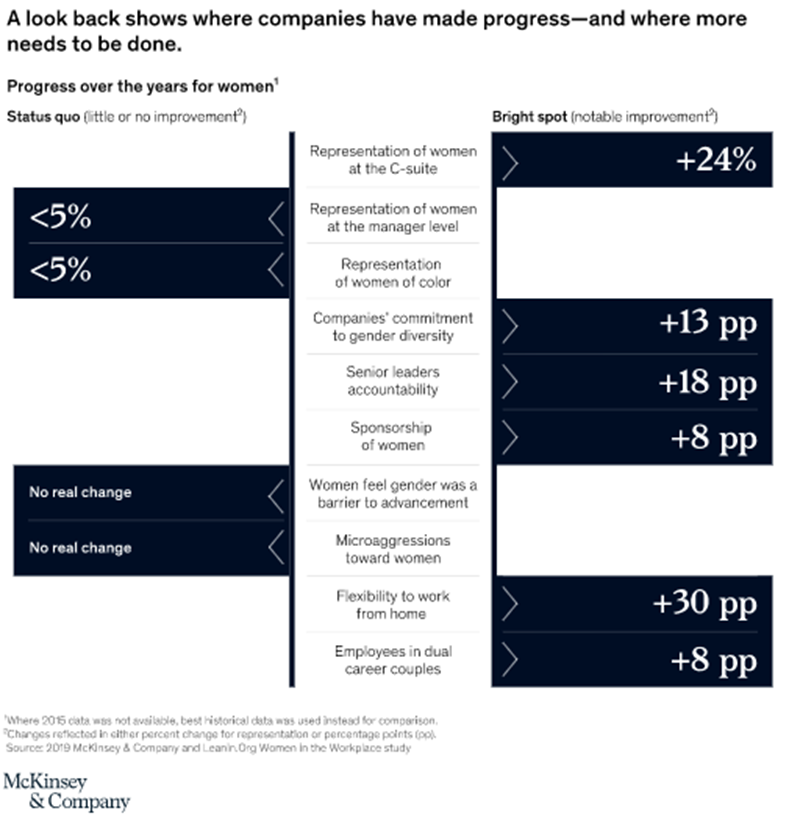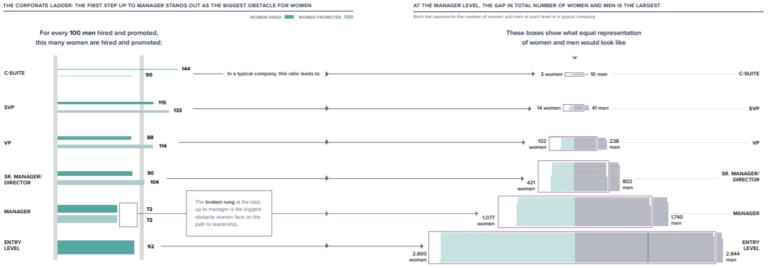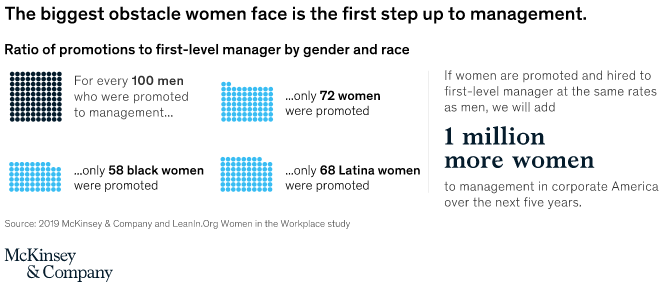New data released in October has shown that businesses in the US are seeing increasing numbers of women being hired and promoted to all levels of their respective organizations. But while there is certainly progress being made, the fifth annual Women in the Workplace report from McKinsey & Company shows that the journey towards gender equality is slow across companies.
At certain levels, this goal of equality still seems out of reach – even as businesses are increasingly showing that they are committed to gender diversity.
The report cites the step up to management as a key issue. It calls it the “broken rung” which is affecting the whole pipeline.
Let’s have a look at some of the report’s key points and assess the takeaways for helping businesses to remove the barrier for women moving up to management.
Evidence of bright spots and ongoing issues
Women in the Workplace 2019 does point to some “notable improvements” over the past five years where gender equality is concerned.
One of the biggest improvements has been made in representation at the C-suite level. The proportion of women in these roles has increased by +24%.
Companies are also increasingly committed to giving women the flexibility to work from home (up +30%), they are seeing more senior leader accountability (+18%) and they are showing better commitment to gender diversity overall (+13%).
But there are also plenty of examples of little or no change. For instance, there has been little positive movement in the representation of women of color across US businesses. Likewise, representation of female voices at management level has seen little growth too. And this is a significant stumbling block.
Step up to management is the broken rung
In corporate America, for every 100 men hired or promoted to management level, just 72 women are taken into these roles.
The disparity here has some unsurprising implications.
The report states: ‘This broken rung results in more women getting stuck at the entry level, and fewer women becoming managers…men end up holding 62 percent of manager-level positions, while women hold just 38 percent.’
It is an obstacle to progression for all women in business, but it is an even bigger issue for minorities – with only 58 black women being promoted for every 100 men who move up, and only 68 Latina women promoted for every 100 men who see progression to this vital step.
5 steps to fixing the broken rung
Perhaps the most enlightening part of the report is the roadmap it offers for businesses so they can address this barrier for women progressing to management level.
McKinsey & Company offers ‘five steps companies can take to fix their broken rung – and ultimately their pipeline’. The report advises that organizations:
- Set a goal for getting more women into first-level management. Some businesses are already doing this. But McKinsey & Company promotes the use of targets “more aggressively.” These goals are particularly important in the context of hiring and promotions and thus need to be publicized to all overseeing these functions, i.e. ‘the processes that most directly shape employee representation.’
- Require diverse slates for hiring and promotions. Diverse slates increase the likelihood that women will be hired or promoted to management level positions going forward.
- Put evaluators through unconscious bias training. ‘Companies are less likely to provide unconscious bias training for employees who participate in entry-level performance reviews than senior-level reviews, but mitigating bias at this stage is particularly important,’ the report says. ‘Candidates tend to have shorter track records early in their careers, and evaluators may make unfair, gendered assumptions about their future potential.’
- Establish clear evaluation criteria. The report states that while evaluation tools should be easy to use and designed to ‘gather objective, measurable input,’ it also promotes the use of additional safeguards which will ‘encourage fair, unbiased evaluations.’
- Put more women in line for the step up to manager. ‘Leadership training, sponsorship, high-profile assignments,’ – these building blocks are evident across many businesses, but in many cases these provisions clearly need to be improved. And where they don’t yet exist, they need to be established ‘with a renewed sense of urgency.’
Takeaways
The Women in the Workplace report series has been a vital annual assessment of ongoing gender equality progress in US business over the past five years. The digital industries, although progressive and agile in many ways, are not immune to often failing completely at representing non-white, non-male persons within their organisations.
The latest report does, broadly, show things to be moving in the right direction and its conclusions are certainly optimistic for the future.
But where the goal of gender parity is concerned, as well as the opportunities for women from minority backgrounds, there is still real work to be done.
It is the crucial step from entry-level positions up to management roles which is the key sticking point. This “broken rung” blocks progression for talent for vast numbers of people.
As the report highlights, internal changes to processes in hiring, promotions and training is certainly achievable for any company. But the time to implement those changes is now.
source https://www.clickz.com/workplace-gender-equality/257729/



No comments:
Post a Comment